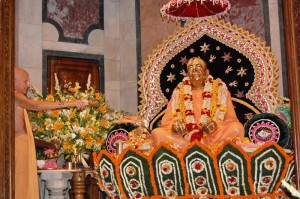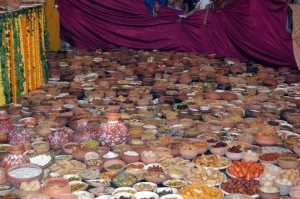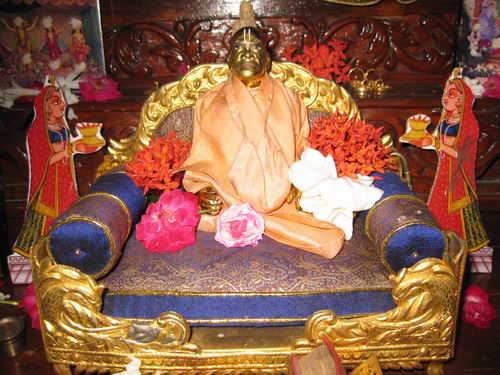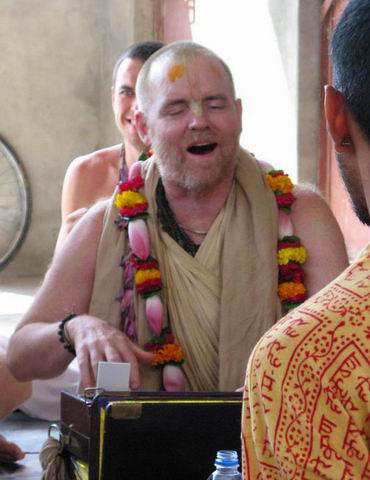|
|
 Another Anniversary (or Two)
Another Anniversary (or Two) On Thursday 22 October 2009 we celebrated Srila Prabhupada’s 32nd Disappearance anniversary

Samadhi arati
here in Mayapur. It was a transcendentally enlivening event, attended by approx. 4,000 yatris from Mumbai and other places, who are all here with HH Radhanath Swami for their Kartika Navadvipa-mandala-parikrama.
We listened to profound recollections, realizations and lilas from Srila Prabhupada’s disciples including Their Holinesses Ramai Swami, Kavicandra Swami, Umapati Swami and Radhanatha Swami, as well as HG Sitala dasi, Ragatmika dasi, Kulingana dasi, Rajendranandan dasa, Pancaratna dasa, Suresvara dasa, Sauri dasa, Bhavananda dasa and many others. We were also glad to welcome and hear from HH Bodhayan Maharaja,

Kavicandra Swami, Radhanatha Swami, Bodhayana Swami
the Acarya of the Gopinatha Gaudiya Matha founded by His Divine Grace Bhakti Pramoda Puri Maharaja.
Afterwards we observed puspanjali and maha-arati in the Puspa Samadhi and this was followed by a wonderful feast,

cooked in the best traditions of ISKCON Mayapur. In the evening we gathered again to hear from Mayapur’s transcendental twins Jananivas and Pankajanghri prabhus and others, before observing the actual time of Srila Prabhupada’s disappearance by singing “Ye anilo prema-dhana….” followed by arati and prasadam distribution.
I can say that personally I thought it was one of the best disappearance festivals I have attended. Many of the talks, especially those of Rajendranandan prabhu and Sitala dasi, were deeply appreciated, and you can download those from the Mayapur website www.mayapur.com
But that’s not what this blog is about. I want to mention another smaller, more personal anniversary.
The Disappearance day this year marked the 20th anniversary of my personal worship to my Deity of Srila Prabhupada.

I guess its a milestone, a marker of devotion. Of course, our worship of Srila Prabhupada is eternal and unending. In that perspective, 20 yrs. isn’t much. But from the view point of a limited life in this Kali-yuga body, it represents one third of my current life’s duration. So I am happy to have achieved it. I want my personal service to His Divine Grace to go on and on, and my little bit of one hour puja everyday helps keep me connected in a way that performing other services don’t.
In late 1988 I was feeling a little adrift. In 1984 I had given up my sannyasa, and with it all my services as GBC of the South Seas. It took me several years to get over the turbulence and by 1988 I was feeling more positive but also feeling a real need to connect with Srila Prabhupada through some personal service. I started to think about worshipping his Deity but in Australia none was to be found. So I decided I would look in Mayapur and Vrindavana at the1989 Gaura Purnima festival.
In February 1989 then, I came to India. I had a cursory look around Navadvip but I knew there would not be much on offer and that Vrndavana would be the best place. In early March I went out to Loi Bazaar and spent the best part of a day seeking a nice Deity but to no avail. I returned to Krsna Balaram Mandir disappointed.
Next morning I had an appointment to see Bhurijan prabhu

on the top floor of the Gurukula. As I approached his room, I ran into Aindra prabhu.

We are old friends and it was during my tenure as GBC of New York in 1982 that, with my encouragement, Aindra made the decision to come and live in Vrndavan. So here he was, standing outside his room, effulgent and smiling and happy to see me. We talked, and he invited me to see his Deities that he was keeping for his personal puja.
Stepping into his room was an event. The whole place was plastered in cow dung, from top to bottom. In the center, taking up most of the space, was a large wooden simhasana with a host of Deities residing there. I was impressed. As we talked, I suddenly thought, “I wonder if Aindra knows where I can get a nice Deity of Srila Prabhupada.”
As soon as I gave voice to my thought, he dipped his hand behind a curtain covering a set of concrete shelves and instantly produced a beautiful murti of His Divine Grace. “Here, you can have him prabhu. He was given to me six months ago but I haven’t worshipped him because I already have another Deity of Prabhupada on my altar.”
I immediately took it as a confirmation from Srila Prabhupada that he wanted me to begin personally worshipping him again. The Deity was exactly what I was looking for. The right size for traveling, and nicely formed. It looked like Srila Prabhupada. I was very happy.
But I didn’t begin worshipping him immediately. I needed to get myself properly situated before I undertook a task I knew that I could not stop once I started. Being “properly situated” meant getting my asrama status in order. i.e. I needed a good devotee wife to stabilize my life so that I could make steady progress in devotional service. Together we could take up the worship. If for some reason I could not do it one day, she could do it instead.
I thought about an incident in Hyderabad in August of 1976. At the opening of the temple Srila Prabhupada had been given a shaligram-shila by Sri Sampath Kumar Bhattacarya, the leader of the S. Indian pandits who had done all the rituals for the installation and opening. Later he called Pradyumna prabhu into his room:
Pradyumna is on the far right
August 21 1976- Hyderabad
[TD4]
Prabhupada turned to Pradyumna prabhu. He asked him if would like to personally worship the salagrama-sila given by Sampath Kumar, which was still sitting on his desk. He obviously had changed his mind about sending the Lord to the Bombay temple.
Prabhupada turned to Pradyumna prabhu. He asked him if would like to personally worship the salagrama-sila given by Sampath Kumar, which was still sitting on his desk. He obviously had changed his mind about sending the Lord to the Bombay temple.
Pradyumna was readily agreeable and so Prabhupada gave him some simple instructions. “So we can carry, and every morning just put in a simhasana and tulasi and water and flower and little fruit. That’s all.” Then turning to the rest of us he said, “He has got tendency to worship.”
“He is brahmana, pandita,” Gargamuni added.
“Panditji,” Prabhupada smiled, calling Pradyumna by his popular sobriquet.
Gargamuni mentioned that Pradyumna was also training his son, Aniruddha, and Prabhupada smilingly added, “Yes, his son will be great pandita. Both of them are devotees — husband and wife; therefore nice son is born. Yatha bijam yatha yoni. Yoni is the mother, bijam is the father.”
Then Prabhupada digressed a little, fondly recalling how his own father, following the advice of his spiritual master, always traveled with salagrama-sila hanging around his neck wrapped in a linen handkerchief. “Yes. So it is safe always, kantha. My father used to carry. Wherever he would stay, ganga-jala, tulasi, decoration; say, half an hour business. My father was a great devotee, yes.”
 Q&As #11 Srila Prabhupada’s brahmin thread
Q&As #11 Srila Prabhupada’s brahmin thread April 15 2009
This final question in the CIS series is from Vyasa Shuno das:
“When you were personal servant of Srila Prabhupada most probably you had a chance to see how Srila Prabhupada changed his Brahmin thread. My question is how many lines it consisted of? I ask because there is an opinion that brahmacari should wear 3 line thread, grihastha should have 9 line thread (3 for his wife) or should we have regular 6 lines thread – the way they are available on the market?”
Answer:
The whole time I was with Srila Prabhupada as far as I remember, he wore six threads on his upavita (sacred brahmin thread). I never heard him say that the number of threads was particularly important. The main thing is to chant the gayatri mantra correctly, it doesn’t matter how many threads are chanted on.
According to HH Sacinandan Swami in his book “The Gayatri Mantra” :
“At the time of second initiation, men receive from their guru a sacred thread called the yajnopavita (or simply upavita). Yajnopavita means literally “that which surrounds Visnu” (yajna=Visnu; upa-vi-ta means surrounding). The idea is that a brahmana wears a thread that surrounds Lord Visnu.
Srila Prabhupada writes: “The sacred thread is a sign of those who are competent to study the Vedas from the acarya or the bona fide spiritual master … The spiritual master accepts only the sincere inquirer as his disciple and gives him the sacred thread.”
Yadubara and his wife Vishakha are given second initiation:
Devotees often wonder how many single strands the upavita should have. The brahmanas in Indian culture usually wear nine threads.
According to some Vaisnavas, these nine threads symbolize the nine processes of bhakti (sravanam, kirtanam etc) Others say they refer to the nine islands of Sri Navadvipa-dhama, and yet others say they represent the nine stages from sraddha to prema, as explained in Bhakti-rasamrta-sindhu, (therefore some Vaisnavas have explained, these three ideas correspond to one another.)
Srila Prabhupada wore three times three threads when he was placed in Samadhi. Other Vaisnavas in the Gaudiya tradition wear six single threads to signify the six Goswamis. From this we can conclude that the exact number of threads is ultimately not so important.”
[end quote from TGM]
While Srila Prabhupada liked us to learn more about our Vaisnava culture he didn’t like it if we got too caught up in the fine details. The main point is to worship Krsna and acceptance of the sacred thread is a major step forward in that process.
Your humble servant,
Hari-sauri dasa
 Women pujaris: another letter from Srila Prabhupada
Women pujaris: another letter from Srila Prabhupada Sriman Gaura prabhu from Canada just sent me this letter from Srila Prabhupada to Amsu das, wherein he clearly affirms the right of women to do pujari work:
Vrindaban
13 August, 1974
74-08-13
Toronto
My Dear Amsu das:
Please accept my blessings. I beg to acknowledge receipt of your letter
dated July 23, 1974 and have noted the contents. Regarding the worship of
our Gaura Nitai by women pujaris, we worship Lord Caitanya in His
householder life when He was with His wife, and not as a sannyasi. So, it is
alright for women to do this service. But, besides this, service is
spiritual and there can be no material designation. In Bhagavad-gita it is
stated by Lord Krishna: striyo vaisyas tatha sudras te’pi yanti param gatim.
The principle is that everyone who is properly initiated and following the
rules and regulations can worship. This activity can not on the material
platform.
According to the smarta vidhi, women cannot touch deity during menstrual
period but the goswami viddhi allows. But it is better not to do it. One
thing is that the seva can never be stopped for any reason. This also for
the cooking.
I hope this meets you in good health.
Your ever well wisher,
A.C. Bhaktivedanta Swami
ACBS/bs/ps
 Q&A: Worship of Tulasi devi on Dvadasi + 17 other questions
Q&A: Worship of Tulasi devi on Dvadasi + 17 other questions December 14 2008
A few months back I got a question from Samatma Gour das in the CIS about Srimati Tulasi devi that I couldn’t answer:
“I heard recently that Tulasi should not be worshiped on dwadashi (take off leaves, touch etc).
I do not trust any “new” information (that appeared after passing away of Shrila Prabhupada) reg. the process of devotional service. So I decided to ask you. Is there any authoritative information about this and what did Shrila Prabhupada say about this?”
At the time I answered non-committally:
“Sorry prabhu, I don’t know anything about this topic. I never heard this before, that Tulasi cannot be touched or leaves picked on dvadasi. Maybe there is some shastric injunction but if there isn’t I wouldn’t give much credence to it unless someone can show some authoritative source to back it up.”
I recently put out the question on the Prabhupada Disciples conference on Pamho.net and got this excellent answer from Sriman Gaura Kesava prabhu, an old friend and fellow disciple of Srila Prabhupada from Australia and an expert on various forms of Deity worship and pujas:
